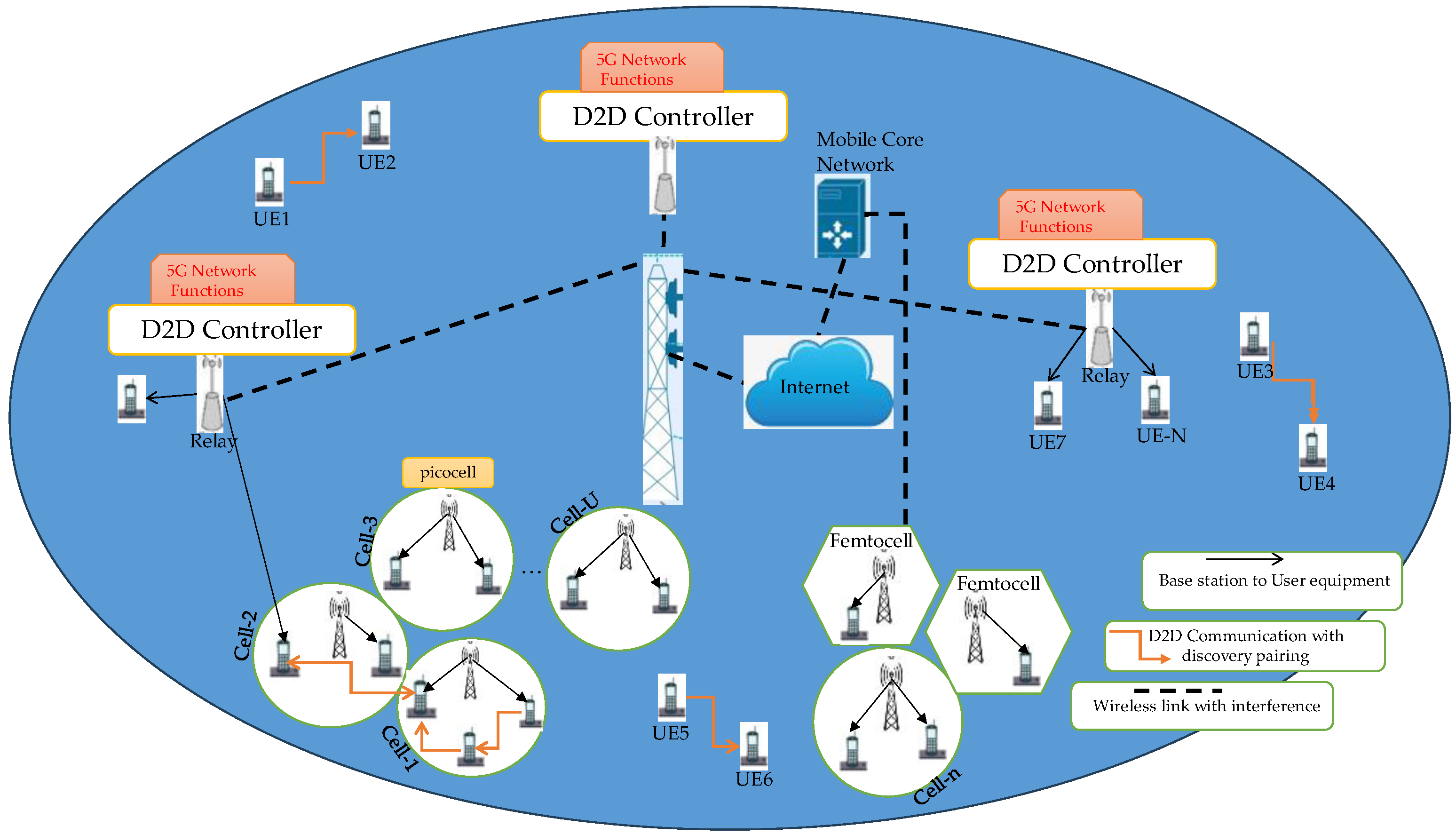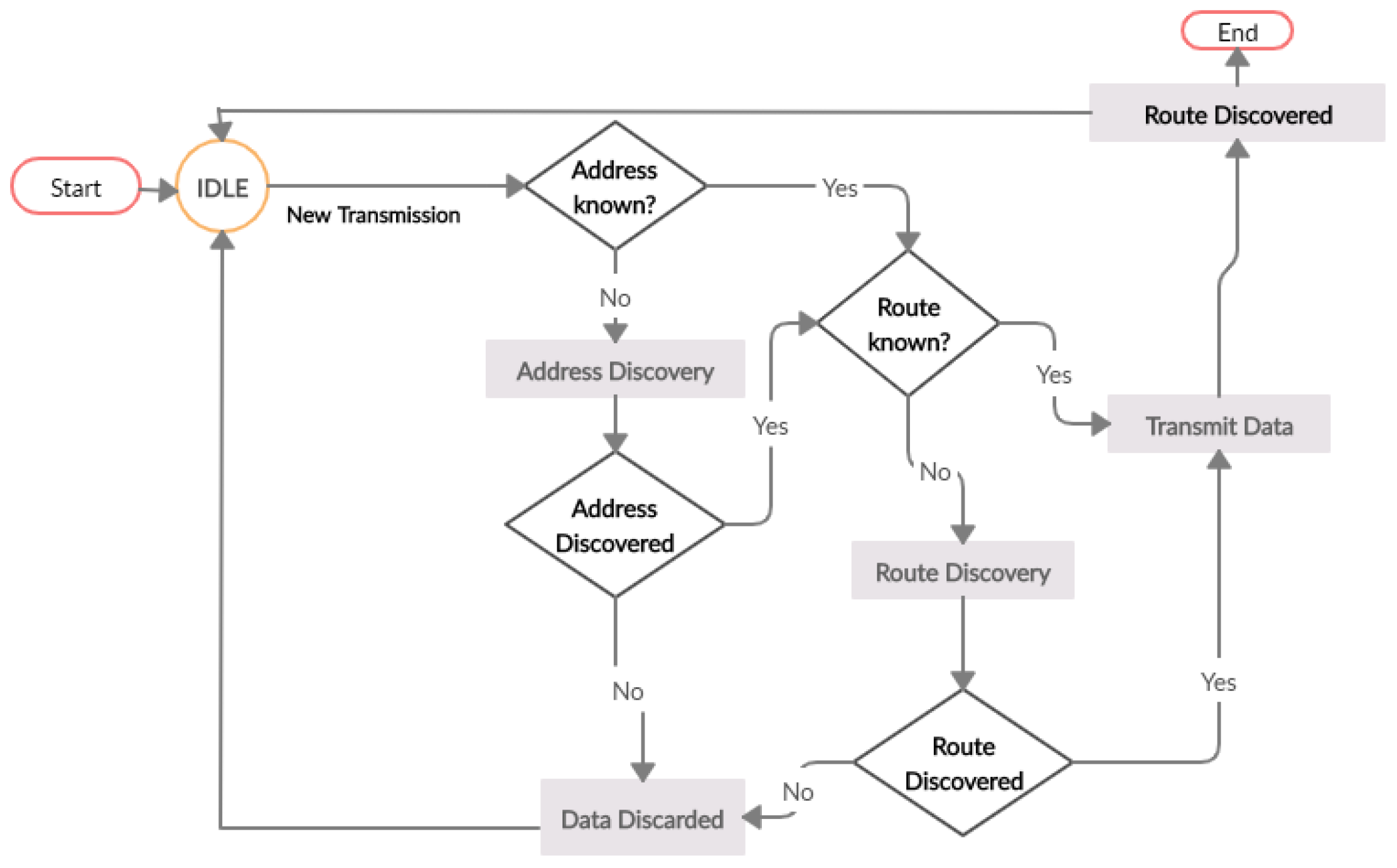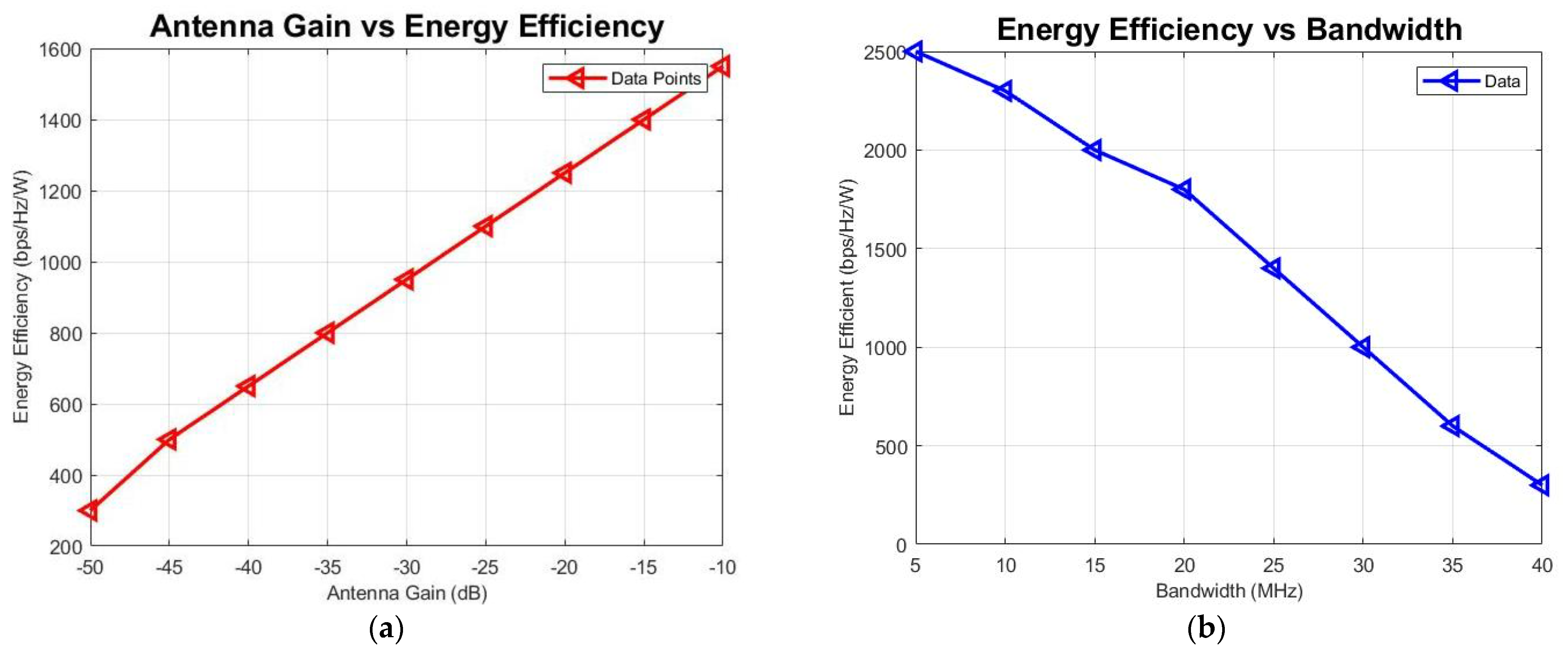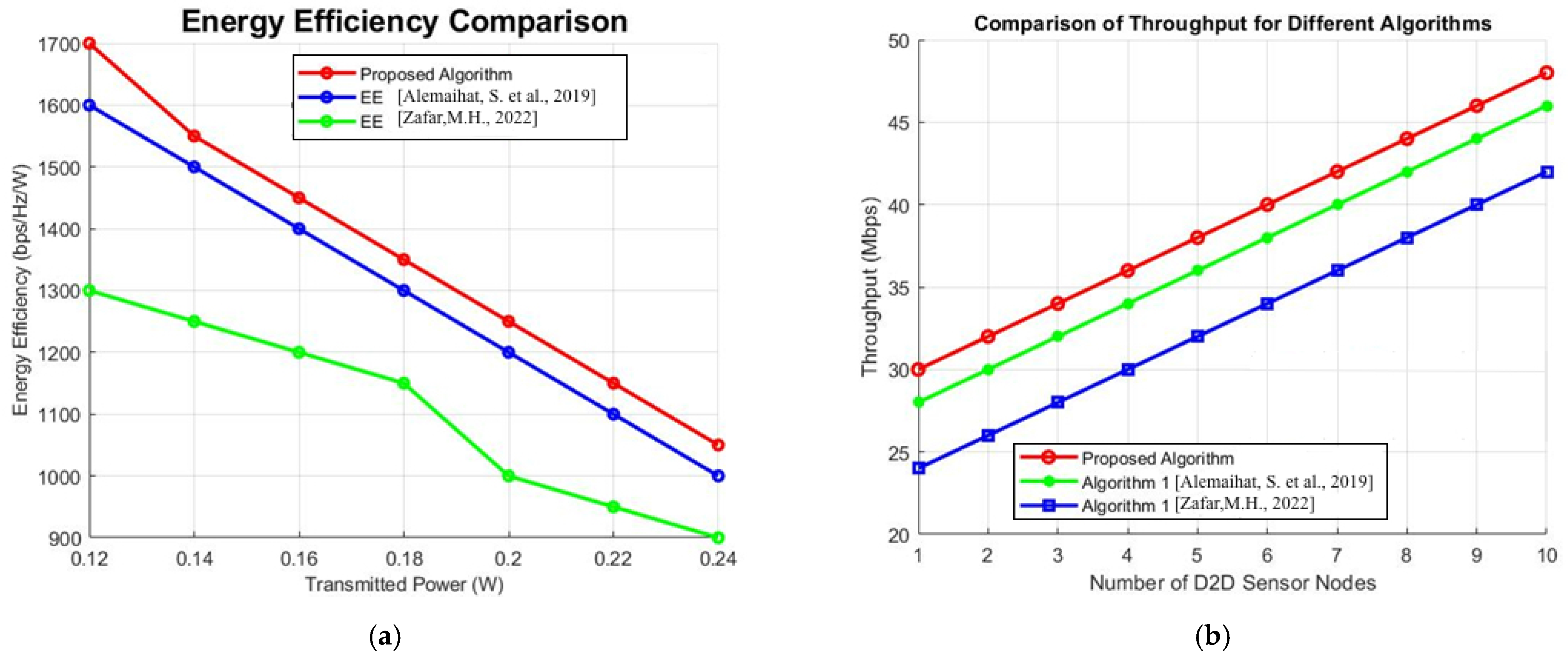Design and Development of Energy Efficient Algorithm for Smart Beekeeping Device to Device Communication Based on Data Aggregation Techniques
Abstract
1. Introduction
2. Literature Review
2.1. Energy Efficiency in 5G Networks
2.2. Need for Smart Beekeeping Device-to-Device Communication (SBD2D)
3. System Model and Architecture Design
3.1. System Overview
3.2. System Communication Model
3.3. Pairing Process of SBD2D Communication
3.4. Communication Phase of Proposed SBD2D System Model
3.5. Data Throughput
3.6. Modeling Energy Consumption
3.7. Energy Efficient Algorithm for SBD2D Based on Data Scheduling
| Algorithm 1: Energy Efficient Scheduling-Based Data Transmission |
| 1. Start 2. Initialize system parameters (n SBD2D nodes and m cellular nodes, data rate, K multiplexed users) 3. Initialize transmission time period 4. For transmission period ≤ 60 s do 5. Compute SINR, from Equation (1) 6. Compute Data rate, from Equation (2) 7. Calculate active & standby ratio 8. Schedule data transfer 9. Estimate energy consumption ET 10. If Estimated energy then 11. Proceed to check priority requests 12. Else 13. Go to step 3 14. For priority requests do 15. Transmit data within a time slot of 2 s 16. For non-priority requests do 17. Send to inactive queue 18. While initialization period s, do 19. Activate inactive non-priority requests to transmit 20. End For 21. End If 22. End Else 23. End For 24. End For 25. End While 26. Exit |
3.8. Impacts of Standby Ratio on Power Consumption
3.9. System Model Based on SBD2D Data Integration
- Energy Efficiency: smart beekeeping systems can significantly increase their energy efficiency with the incorporation of D2D communication and data integration techniques. As opposed to conventional centralized communication techniques, the energy necessary for transferring data through intermediaries is drastically reduced when communicating directly between nodes. Data integration methods also reduce unnecessary transfers, which helps to save power.
- Reduced Transmission Overhead: fewer transmissions are needed to send information to the base station when the data are integrated at the node level. Instead of delivering numerous separate data packets, an aggregated data packet is sent. In addition to saving energy, network optimization is also achieved.
- Minimized Latency: D2D communication and data integration enables real-time data exchange between neighboring nodes; in this instance, nodes from one beehive to another, ensuring a low transmission latency. This immediate data transmission enables quick decisions and responses to changes in hive conditions, thereby enhancing the hive management and bee productivity
4. Results and Discussion
4.1. Numerical Results—SBD2D Communication Using Data Scheduling
4.2. Numerical Results—SBD2D Energy-Efficient Algorithm
4.3. Numerical Results—SBD2D Communication Using Data Integration
4.4. Performance Analysis of Proposed Model
Performance Comparison
5. Conclusions and Future Work
Author Contributions
Funding
Institutional Review Board Statement
Informed Consent Statement
Data Availability Statement
Conflicts of Interest
References
- Doppler, K.; Ribeiro, C.B.; Kneckt, J. Advances in D2D communications: Energy efficient service and device discovery radio. In Proceedings of the 2011 2nd International Conference on Wireless Communication, Vehicular Technology, Information Theory and Aerospace & Electronics Systems Technology (Wireless VITAE), Chennai, India, 28 February–3 March 2011; IEEE: Piscataway, NJ, USA, 2011. [Google Scholar]
- Hadyanto, D.P.; Novariana, D.S.; Wulandari, A. Device-to-device communication in 5G. In Proceedings of the International Joint Conference on Science and Engineering 2021 (IJCSE), Online, Serbia, 15–17 July 2021; Atlantis Press: Amsterdam, The Netherlands, 2021; pp. 649–654. [Google Scholar]
- Chai, Y.; Du, Q.; Ren, P. Partial time-frequency resource allocation for device-to-device communications underlaying cellular networks. In Proceedings of the 2013 IEEE International Conference on Communications (ICC), Budapest, Hungary, 9–13 June 2013; IEEE: Piscataway, NJ, USA, 2013. [Google Scholar]
- Astely, D.; Dahlman, E.; Fodor, G.; Parkvall, S.; Sachs, J. LTE Release 12 and Beyond. IEEE Commun. Mag. 2013, 51, 154–160. [Google Scholar] [CrossRef]
- MAlsharif, H.; Nordin, R.; Abdullah, N.F.; Kelechi, A.H. How to make key 5G wireless technologies environmentally friendly: A review. Trans. Emerg. Telecommun. Technol. 2018, 29, e3254. [Google Scholar] [CrossRef]
- Ericsson Mobility Report 2018. November 2018. Available online: https://www.ericsson.com/assets/local/mobility-report/documents/2018/ericsson-mobility-report-november-2018.pdf (accessed on 24 May 2020).
- Nagapuri, L.; Prabu, A.V.; Penchala, S.; Salah, B.; Saleem, W.; Kumar, G.S.; Aziz, A.S.A. Energy Efficient Underlaid D2D Communication for 5G Applications. Electronics 2022, 11, 2587. [Google Scholar] [CrossRef]
- Adachi, T.; Nakagawa, M. A study on channel usage in a cellular ad-hoc united communication system. IEICE Trans. Commun. 1998, E81-B, 1500–1507. [Google Scholar]
- Asadi, A.; Wang, Q.; Mancuso, V. A survey on device-to-device communication in cellular networks. IEEE Commun. Surv. Tutor. 2014, 16, 1801–1819. [Google Scholar] [CrossRef]
- Jedari, B.; Xia, F.; Ning, Z. A Survey on Human-Centric Communications in Non-Cooperative Wireless Relay Networks. IEEE Commun. Surv. Tutor. 2018, 20, 914–944. [Google Scholar] [CrossRef]
- Qiu, X.; Xuewen, L.; Dong, K.; Zhu, S. Energy Efficiency Analysis in Device-to-Device Communication Underlying Cellular Networks. In Proceedings of the 2013 IEEE 10th Consumer Communications and Networking Conference (CCNC), Las Vegas, NV, USA, 11–14 January 2013. [Google Scholar]
- Alemaishat, S.; Saraereh, O.A.; Khan, I.; Choi, B.J. An Efficient Resource Allocation Algorithm for D2D Communications Based on NOMA. IEEE Access 2019, 7, 120238–120247. [Google Scholar] [CrossRef]
- Zafar, M.H. An Efficient Resource Optimization Scheme for D2D Communication; Springer: Berlin/Heidelberg, Germany, 2022. [Google Scholar]
- Jung, M.; Hwang, K.; Choi, S. Joint Mode Selection and Power Allocation Scheme for Power-Efficient Device-to-Device (D2D) Communication. In Proceedings of the 2012 IEEE 75th Vehicular Technology Conference (VTC Spring), Yokohama, Japan, 6–9 May 2012. [Google Scholar]
- Yaacoub, E.; Ghazzai, H.; Alouini, M.-S.; Abu-Dayya, A. Achieving energy efficiency in LTE with joint D2D communications and green networking techniques. In Proceedings of the 2013 9th International Wireless Communications and Mobile Computing Conference (IWCMC), Sardinia, Italy, 1–5 July 2013. [Google Scholar]
- Doppler, K.; Rinne, M.; Wijting, C.; Ribeiro, C.B.; Hugl, K. Device-to-Device Communication as an Underlay to LTE-Advanced Networks. IEEE Commun. Mag. 2009, 47, 42–49. [Google Scholar] [CrossRef]
- Fodor, G.; Dahlman, E.; Mildh, G.; Parkvall, S.; Reider, N.; Miklós, G.; Turányi, Z. Design Aspects of Network Assisted Device-to-Device Communications. IEEE Commun. Mag. 2012, 50, 170–177. [Google Scholar] [CrossRef]
- Feng, D.; Lu, L.; Yuan-Wu, Y.; Li, G.Y.; Feng, G.; Li, S. Device-to-Device Communications Underlaying Cellular Networks. IEEE Trans. Commun. 2013, 61, 3541–3551. [Google Scholar] [CrossRef]
- Hussain, F.; Hassan, M.Y.; Hossen, M.S.; Choudhury, S. System capacity maximization with efficient resource allocation algorithms in D2D communication. IEEE Access 2018, 6, 32409–32424. [Google Scholar] [CrossRef]
- Li, J.; Lei, G.; Manogaran, G.; Mastorakis, G.; XMavromoustakis, C. D2D communication mode selection and resource optimization algorithm with optimal throughput in 5G network. IEEE Access 2019, 7, 25263–25273. [Google Scholar] [CrossRef]
- Höyhtyä, M.; Apilo, O.; Lasanen, M. Review of Latest Advances in 3GPP Standardization: D2D Communication in 5G Systems and Its Energy Consumption Models. Future Internet 2018, 10, 3. [Google Scholar] [CrossRef]
- Cisco Visual Networking Index: Global Mobile Data Traffic Forecast Update, 2015–2020. December 2016. Available online: www.cisco.com (accessed on 1 June 2023).
- Zappone, A.; Jorswieck, E. Energy efficiency in wireless networks via fractional programming theory. Found. Trends Commun. Inf. Theory 2015, 11, 185–396. [Google Scholar] [CrossRef]
- Ericsson White Paper. More than 50 billion connected devices. Ericsson Tech. Rep. 2011, 284, 23–3149. [Google Scholar]
- Andrew, J.G.; Buzzi, S.; Choi, W.; Hanly, S.V.; Lozano, A.; Soong, A.C.K.; Zhang, J.C. What will 5g be? IEEE J. Sel. Areas Commun. 2014, 32, 1065–1082. [Google Scholar] [CrossRef]
- Venturino, L.; Zappone, A.; Risi, C.; Buzzi, S. Energy-efficient scheduling and power allocation in downlink ofdma networks with base station coordination. IEEE Trans. Wirel. Commun. 2015, 14, 1–14. [Google Scholar] [CrossRef]
- Kamruzzaman, M.; Sarkar, N.I.; Gutierrez, J. A dynamic algorithm for interference management in D2D-enabled heterogeneous cellular networks: Modeling and analysis. Sensors 2022, 22, 1063. [Google Scholar] [CrossRef]
- Zappone, A.; Sanguinetti, L.; Bacci, G.; Jorswieck, E.A.; Debbah, M. Energy-efficient power control: A look at 5G wireless technologies. IEEE Trans. Signal Process. 2016, 64, 1668–1683. [Google Scholar] [CrossRef]
- Sinaie, M.; Zappone, A.; Jorswieck, E.; Azmi, P. A novel power consumption model for effective energy efficiency in wireless networks. IEEE Wirel. Commun. Lett. 2015, 5, 152–155. [Google Scholar] [CrossRef]
- She, C.; Yang, C.; Liu, L. Energy-efficient resource allocation for MIMO-OFDM systems serving random sources with statistical QoS requirement. IEEE Trans. Commun. 2015, 63, 4125–4141. [Google Scholar] [CrossRef]
- Lynch, J.P.; Loh, K.J. A summary review of wireless sensors and sensor networks for structural health monitoring. Shock. Vib. Dig. 2006, 38, 91–130. [Google Scholar] [CrossRef]
- Sazonov, E.; Janoyan, K.; Jha, R. Wireless intelligent sensor network for autonomous structural health monitoring. Smart Struct. Mater. 2004 Smart Sens. Technol. Meas. Syst. 2004, 5384, 305–315. [Google Scholar]
- Palma, L.; Pernini, L.; Belli, A.; Valenti, S.; Maurizi, L.; Pierleoni, P. Ipv6 WSN solution for integration and interoperation between a smart home and AAL systems. In Proceedings of the 2016 IEEE Sensors Applications Symposium (SAS), Catania, Italy, 20–22 April 2016; pp. 1–5. [Google Scholar]
- Yadav, S.; Narayanankutty, K.A. A Industrial Timer and Real Time Keeper. Wirel. Eng. Technol. 2011, 2, 196–203. [Google Scholar] [CrossRef]












| Notation | Definition |
|---|---|
| SINR | Signal to Interference and Noise to ratio |
| QoS | Quality of Service |
| KD2D | The fading coefficients of the D2D link |
| SBD2D | Smart beekeeping device-to-device communication |
| Symbolizes the path-loss exponent | |
| AWGN | Additive white Gaussian noise |
| To | Variance |
| CUE | Cellular user equipment |
| DT | Data throughput |
| TP | Transmitter power with amplifier inefficiency |
| FP | Fixed circuit power |
| PC | Power per transceiver chain |
| A | The coding/decoding/backhaul |
| B | Bandwidth of the line |
| K | Multiplexed users |
| KDR | The link between the UE (D2D User Equipment) receiver and the Uth UE transmitter |
| KD2D | The fading coefficients of the D2D link |
| UE | User equipment |
| BDR | The complex normal distribution |
| r | The D2D link that uses the channel g |
| Data rate | |
| Mcn | Transmit power of D2D Transmitter |
| MD | Transmit power of cellular user equipment |
| eNB | Evolved node B |
| SCeNB | Small cell evolved node B |
| Active to Standby Ratio | % Time in Standby | Time active × I active (µAs) | Time standby × I standby (µAs) | Total Charge (µAs) | % Impact of I Standby to Total Power |
|---|---|---|---|---|---|
| 1:10 | 90% | 100 | 5 | 105 | 6.54% |
| 1:100 | 99% | 100 | 50 | 150 | 33% |
| 1:1000 | 99.9% | 100 | 500 | 600 | 83.3% |
| Parameter | Value |
|---|---|
| Bandwidth (MHz) | 40 |
| Area (m) | 4 × m |
| Pathloss exponent | 3.76 |
| Noise over pathloss at 1 km (dBm) | 33 |
| Amplifier efficiency | 0.39 |
| Quality of Service requirements (Mbps) | 50 for at least 95% of the user |
| SINR Threshold (dB) | 3 |
| Type of D2D channel model | Free space Propagation channel |
| Static power (W) | 10 |
| Circuit power per active user (W) | 0.1 |
| Circuit power per BS Antenna (W) | 0.2 |
| Signal processing coefficient (mW) | 3.12 |
| Antenna Gain (dB) | G0 = 20 |
| Noise power spectral density (dBm/Hz) | −154 |
| Receiver node (dB) | 7 |
| Coding/decoding/backhaul (bit/J) | 1.15.10−9 |
Disclaimer/Publisher’s Note: The statements, opinions and data contained in all publications are solely those of the individual author(s) and contributor(s) and not of MDPI and/or the editor(s). MDPI and/or the editor(s) disclaim responsibility for any injury to people or property resulting from any ideas, methods, instructions or products referred to in the content. |
© 2023 by the authors. Licensee MDPI, Basel, Switzerland. This article is an open access article distributed under the terms and conditions of the Creative Commons Attribution (CC BY) license (https://creativecommons.org/licenses/by/4.0/).
Share and Cite
Ntawuzumunsi, E.; Kumaran, S.; Sibomana, L.; Mtonga, K. Design and Development of Energy Efficient Algorithm for Smart Beekeeping Device to Device Communication Based on Data Aggregation Techniques. Algorithms 2023, 16, 367. https://doi.org/10.3390/a16080367
Ntawuzumunsi E, Kumaran S, Sibomana L, Mtonga K. Design and Development of Energy Efficient Algorithm for Smart Beekeeping Device to Device Communication Based on Data Aggregation Techniques. Algorithms. 2023; 16(8):367. https://doi.org/10.3390/a16080367
Chicago/Turabian StyleNtawuzumunsi, Elias, Santhi Kumaran, Louis Sibomana, and Kambombo Mtonga. 2023. "Design and Development of Energy Efficient Algorithm for Smart Beekeeping Device to Device Communication Based on Data Aggregation Techniques" Algorithms 16, no. 8: 367. https://doi.org/10.3390/a16080367
APA StyleNtawuzumunsi, E., Kumaran, S., Sibomana, L., & Mtonga, K. (2023). Design and Development of Energy Efficient Algorithm for Smart Beekeeping Device to Device Communication Based on Data Aggregation Techniques. Algorithms, 16(8), 367. https://doi.org/10.3390/a16080367







